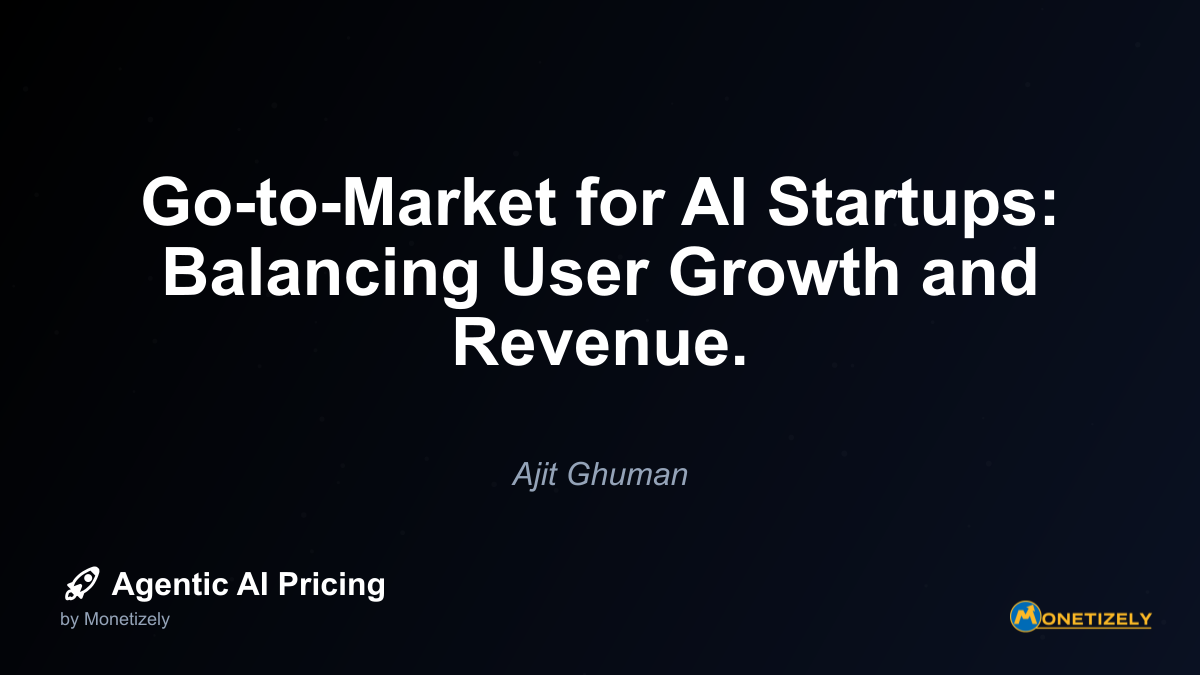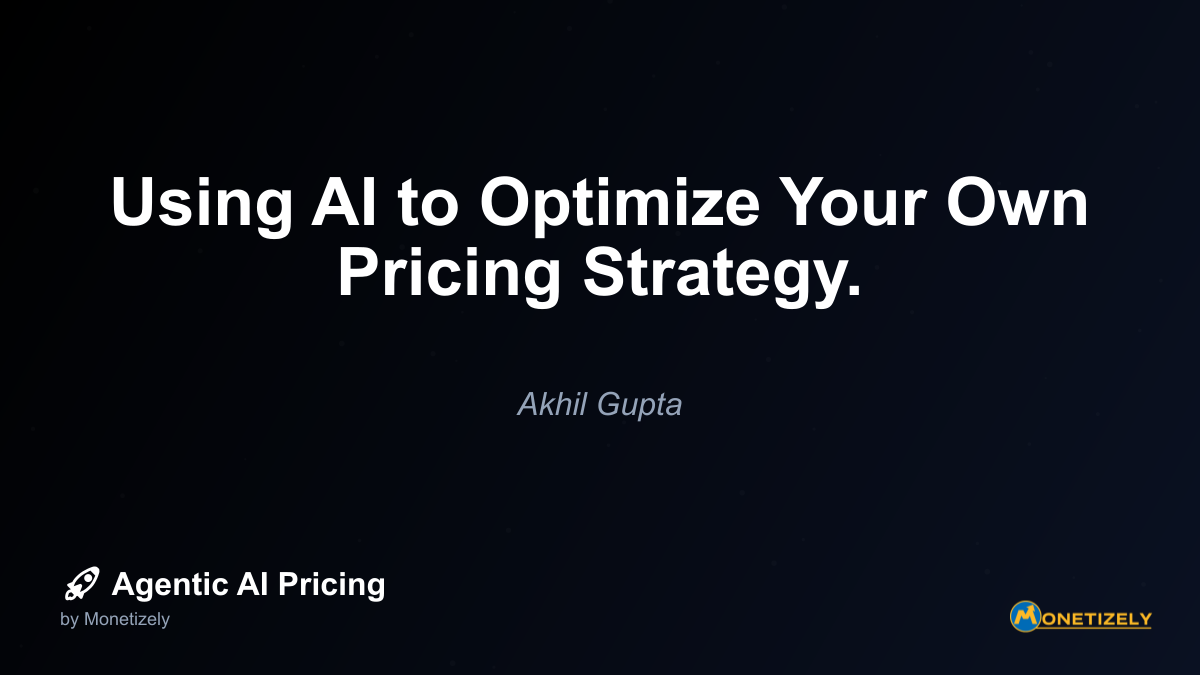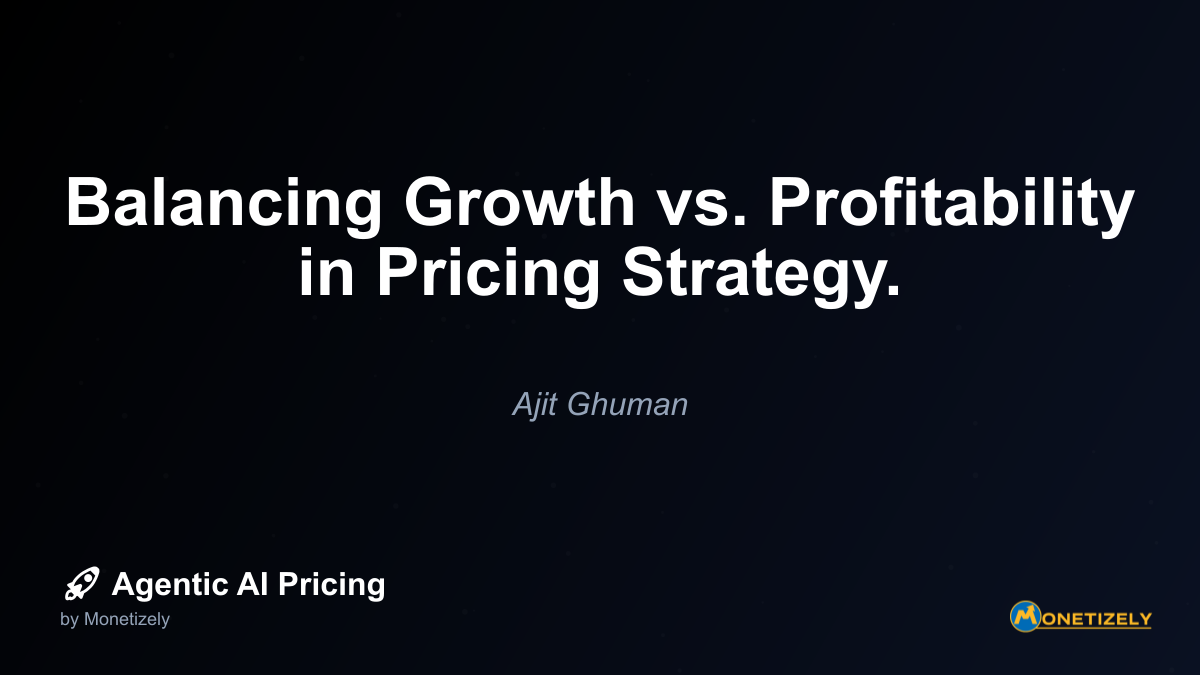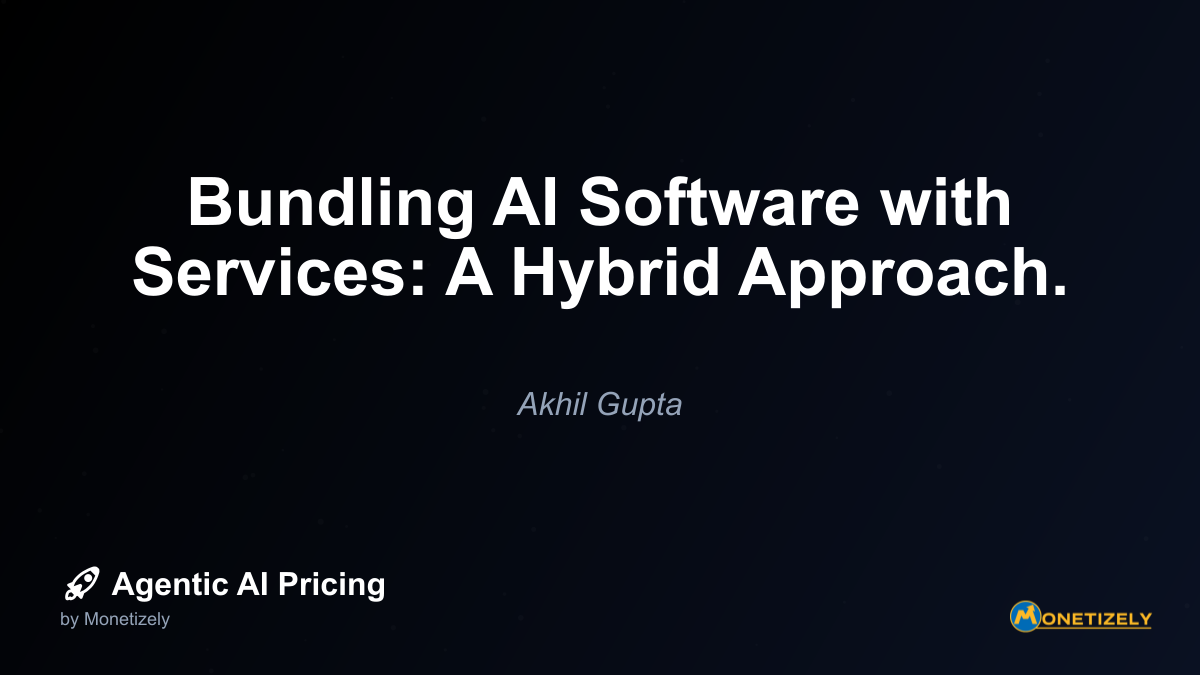· Ajit Ghuman · Strategy & Planning · 9 min read
Choosing the Right Pricing Metric (User, Transaction, Value) for Your AI
AI and SaaS Pricing Masterclass
Learn the art of strategic pricing directly from industry experts. Our comprehensive course provides frameworks and methodologies for optimizing your pricing strategy in the evolving AI landscape. Earn a professional certification that can be imported directly to your LinkedIn profile.
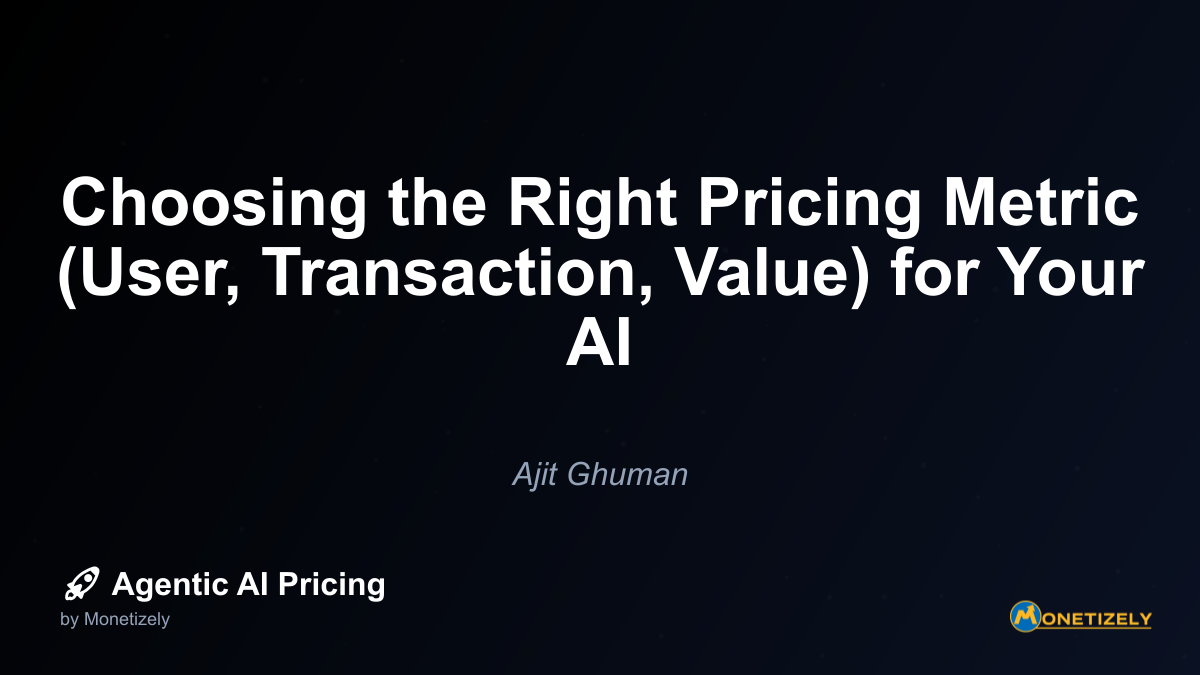
Implementation Complexity
The practicality of your pricing metric matters. Consider these implementation factors:
- Measurement clarity: Can you accurately track and measure the metric?
- Technical feasibility: What systems are required to monitor and bill based on the metric?
- Auditability: Can both you and customers easily verify the accuracy of measurements?
Per-user pricing tends to be simplest to implement, while value-based approaches often require sophisticated tracking systems and may involve more complex contractual arrangements. Transaction and data volume models fall somewhere in between, requiring reliable usage monitoring but with relatively straightforward measurement.
For more depth on measuring and tracking AI usage metrics, you might find our guide on AI Pricing Metrics for Beginners helpful.
Competitive Positioning
Your pricing metric also influences how customers compare your offering to alternatives. Some considerations:
- Industry norms: Do competitors use similar metrics, making direct comparisons easy?
- Differentiation: Could an unconventional metric help highlight your unique value?
- Comparison difficulty: Does your metric make it harder for customers to make direct price comparisons?
For example, if competitors charge per user but your AI delivers exceptional value per transaction, a transaction-based model might better highlight your advantage. Conversely, using a non-standard metric might create friction in the sales process if customers struggle to compare costs.
Evaluating the Four Models Against Key Criteria
Now let’s evaluate each of the four primary pricing metrics against our key criteria:
Per-User Pricing Evaluation
Value Alignment: Strong for applications where value scales with the number of individuals benefiting from the AI. Weak for applications where a small number of users might derive enormous value or where usage varies dramatically between users.
Predictability: Excellent. Costs are highly predictable for customers, making budgeting straightforward.
Revenue Potential: Moderate. Revenue scales linearly with customer organization size, but not necessarily with value delivered or usage intensity.
Implementation Complexity: Low. Relatively straightforward to track licensed users.
Competitive Positioning: Strong in markets where per-user pricing is the norm (e.g., productivity tools), potentially weak in markets where transaction or value-based pricing dominates.
Best For: Collaborative AI tools, productivity enhancers, and applications where value is primarily tied to individual user productivity.
Transaction-Based Pricing Evaluation
Value Alignment: Strong for applications where each interaction delivers discrete, consistent value. Weaker for applications where value comes from cumulative insights or where transaction volume doesn’t correlate with value.
Predictability: Moderate to low, depending on usage patterns. Can create budget uncertainty for customers.
Revenue Potential: High. Revenue scales directly with usage, which often correlates with value received.
Implementation Complexity: Moderate. Requires reliable transaction counting and may involve managing usage spikes.
Competitive Positioning: Strong in API-driven markets and where usage-based pricing is established.
Best For: API services, discrete task automation, content generation, and applications where each interaction delivers measurable value.
Data Volume Pricing Evaluation
Value Alignment: Strong for applications where the amount of data processed directly correlates with value delivered. Weak where small data volumes might yield high-value insights.
Predictability: Moderate. More predictable than transaction pricing if data volumes are stable, but still variable.
Revenue Potential: High for data-intensive applications. Scales with customer data growth.
Implementation Complexity: Moderate. Requires accurate volume measurement and potential handling of data privacy concerns.
Competitive Positioning: Strong in data processing and analytics markets.
Best For: Data analysis, large-scale processing, machine learning training, and applications where data volume correlates with complexity and value.
Value-Based Pricing Evaluation
Value Alignment: Excellent. Creates direct alignment between costs and benefits.
Predictability: Variable. Highly predictable as a percentage of value but may be less predictable in absolute terms.
Revenue Potential: Highest. Directly captures a share of the value created.
Implementation Complexity: High. Requires sophisticated tracking, clear attribution, and often custom contractual arrangements.
Competitive Positioning: Can be highly differentiated but may face resistance in markets not accustomed to this model.
Best For: Revenue optimization, cost reduction tools, and applications with clear, measurable financial impact.
Hybrid Approaches: The Best of Multiple Worlds
While the four primary models provide a strong foundation, many successful AI businesses employ hybrid approaches that combine elements of multiple pricing metrics. These hybrid models can address the weaknesses of individual approaches while maintaining their strengths.
Common hybrid approaches include:
Base + Usage
This model combines a predictable base fee (often per user or per account) with variable usage charges. This provides revenue stability while allowing costs to scale with intensive usage.
Example: An AI document processing system might charge $100 per month per department plus $0.05 per document processed.
Tiered Transaction Pricing
This approach uses transaction-based pricing but with volume discounts or usage tiers that improve predictability and reward scale.
Example: An AI translation service might charge $0.10 per 100 words for the first 10,000 words, $0.08 per 100 words for the next 50,000 words, and $0.05 per 100 words beyond that.
Floor and Ceiling Value-Based
This hybrid sets minimum and maximum fees around a value-based pricing core, providing predictability for both vendor and customer while maintaining value alignment.
Example: An AI sales optimization tool might charge 10% of incremental revenue, with a minimum of $5,000 per month and a maximum of $50,000 per month.
Multi-Dimensional Pricing
Some AI services price along multiple dimensions simultaneously, creating a matrix that more precisely matches cost to value.
Example: An AI customer service platform might charge based on both the number of customer service agents (user dimension) and the volume of customer interactions (transaction dimension).
These hybrid approaches can offer more nuanced alignment between pricing and value, though they typically come with increased complexity in both explanation and implementation.
Practical Steps for Selecting Your Pricing Metric
How should you approach the selection process? Follow these steps:
1. Map Your Value Creation Mechanisms
Start by clearly articulating exactly how your AI creates value for customers. Is it primarily through:
- Time savings for users?
- Improved decision quality?
- Cost reduction?
- Revenue enhancement?
- Risk mitigation?
The more precisely you can identify value creation, the better you can align your pricing metric.
2. Analyze Customer Usage Patterns
Examine how customers actually use your AI. Look for patterns in:
- Usage frequency and intensity
- Value derived from different interaction types
- Correlation between usage metrics and customer outcomes
- Variation across customer segments
This analysis may reveal natural units of value that aren’t immediately obvious.
3. Conduct Customer Research
Don’t rely solely on internal analysis. Talk to customers about how they perceive and measure the value they receive:
- How do they justify the investment internally?
- What metrics do they use to evaluate success?
- How do they think about the cost structure?
- What would make budgeting easier for them?
4. Assess Implementation Requirements
For each potential pricing metric, evaluate what would be required to implement it:
- Technology infrastructure needs
- Measurement and verification processes
- Billing system capabilities
- Contract structure changes
- Sales team training
5. Test Multiple Approaches
When possible, test different pricing metrics with different customer segments or through time-limited pilots. Measure:
- Customer acquisition efficiency
- Adoption and expansion rates
- Customer satisfaction and perceived value
- Revenue per customer
- Operational complexity
Common Pitfalls to Avoid
As you select your pricing metric, be aware of these common mistakes:
Choosing What’s Easiest to Measure
Many companies default to metrics that are easy to track rather than those that best align with value. While implementation simplicity matters, it shouldn’t override value alignment.
Ignoring Customer Budgeting Processes
Your pricing metric must work within your customers’ budgeting constraints. A perfectly aligned metric that makes budgeting impossible will create adoption barriers.
Selecting Metrics That Create Adverse Incentives
Some metrics inadvertently discourage optimal product usage. For example, per-query pricing might discourage users from running exploratory analyses that could yield valuable insights.
Overcomplicating the Model
Complexity can kill adoption. While hybrid models offer benefits, each additional dimension increases the cognitive load on potential customers and can extend sales cycles.
Failing to Evolve as Your AI Evolves
As your AI capabilities mature, the way it creates value may change, potentially requiring a shift in pricing metric. Build in mechanisms to review and adjust your approach over time.
Case Studies: Pricing Metrics in Action
Let’s examine how different AI companies have approached pricing metrics:
Case Study 1: OpenAI’s GPT Models
OpenAI uses a transaction-based approach for its API, charging per token (roughly 4 characters) processed. This creates direct alignment between usage intensity and cost, while allowing for simple scaling from small experiments to production deployments.
For ChatGPT Plus, they’ve opted for a subscription model ($20/month) that provides unlimited access within usage limits. This hybrid approach offers predictability for users while protecting OpenAI from extreme usage patterns.
Case Study 2: Jasper AI
This AI writing assistant uses a hybrid model combining per-user elements with usage limits. Their Business plan charges per seat but includes a fixed word generation limit, with additional words available for purchase.
This approach balances predictability with usage alignment and creates natural expansion opportunities as both user count and usage intensity grow.
Case Study 3: Salesforce Einstein
Salesforce’s AI capabilities use primarily per-user pricing, consistent with their overall pricing strategy. This creates simplicity and predictability but may not fully capture value for power users who derive exceptional benefits.
Case Study 4: Drift’s Conversational AI
Drift prices its conversational marketing platform on a hybrid model that considers both the number of website visitors (a proxy for potential value) and the features activated. This multi-dimensional approach ties costs more closely to both scale and value.
Conclusion: The Path Forward
Selecting the right pricing metric for your AI solution requires balancing multiple considerations, from value alignment to implementation complexity. The strongest approaches typically share these characteristics:
- They align costs with the customer’s perception of value
- They scale naturally as customer value increases
- They offer reasonable predictability for budgeting
- They’re straightforward to explain and understand
- They create healthy usage incentives
Remember that your pricing metric is not just a mechanism for capturing revenue—it’s a strategic choice that influences how customers perceive, adopt, and utilize your AI solution. When aligned properly, your pricing metric becomes a powerful tool for communicating value and differentiating your offering in the market.
As AI continues to evolve, we’ll likely see further innovation in pricing models. Value-based approaches may become more prevalent as measurement capabilities improve, while new hybrid models will emerge to address the unique characteristics of advanced AI systems.
The most successful AI companies will be those that view pricing not as a one-time decision but as an ongoing strategic process—one that evolves alongside their technology, customer base, and market position.
By focusing on the fundamental alignment between your pricing metric and the value your AI delivers, you create the foundation for sustainable growth and customer relationships built on mutual benefit rather than transactional exchanges.
Co-Founder & CEO
Ajit is the author of Price To Scale, a top book on SaaS Pricing and is the Founder of Monetizely. Ajit has led and worked in pricing and product marketing at firms like Twilio, Narvar and Medallia. His work has been featured in Forbes and VentureBeat. Ajit regularly consults with software companies from Seed stage to post-IPO on pricing strategy. Ajit is also a highly-rated co-instructor for 'The Art of SaaS Pricing and Monetization' on Maven.
Pricing Strategy Audit
Let our experts analyze your current pricing strategy and identify opportunities for improvement. Our data-driven assessment will help you unlock untapped revenue potential and optimize your AI pricing approach.

